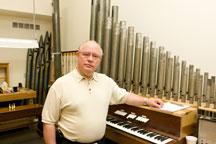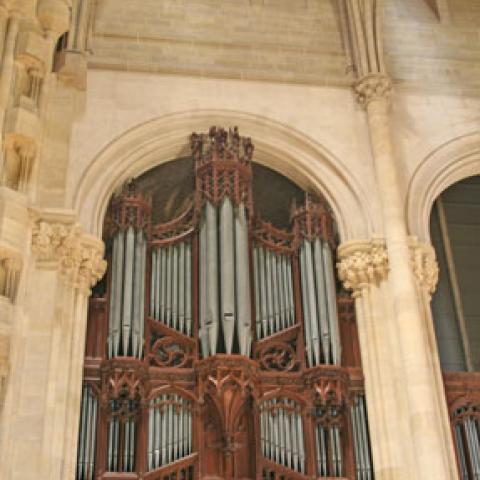
Quimby Builds Organ Business Reputation Pipe by Pipe
In big, bold letters, a web announcement for The Cathedral Church of Saint John the Divine in New York City heralds an event symbolizing progress made since a fire swept through an unfinished section of this historic church nearly seven years ago: “Beginning on Sunday, on November 30, 2008, the Great Organ will again be heard, the legendary Bernini and Mortlake tapestries will be viewable and the Rose Window will sparkle.”
As plans for the rededication service at the world’s largest gothic cathedral unfold, the involvement of a University of Central Missouri alumnus has piqued the interest of the associate editor of The New York Times, Craig Whitney. Michael Quimby, a longtime Warrensburg resident who is founder, president and tonal director of Quimby Pipe Organs, Inc., is overseeing the restoration of the cathedral’s massive Aeolian-Skinner pipe organ that was temporarily silenced after the blaze. Since forming his company in 1970, he has developed an outstanding reputation in the pipe organ industry that not only contributed to his selection as a 2008 UCM Distinguished Alumni Award winner, but ultimately led his crew to the Big Apple.
“We got involved with this project following the fire in December 2001, and were asked to be one of three firms to look into restoring and bringing the instrument back to its unique and original playing condition,” Quimby says. “We received the job three years ago. It took five 53-foot trailers to bring it to Warrensburg, all 37 tons of it.”
Once the organ has been restored to its original condition and returned to St. John’s, the sound emanating from its beautiful pipes will fill a building that stretches the length of two football fields and has been under construction since in 1892. It’s a grand-scale project – even the scaffolding which is needed to work on the instrument in the building’s north and south chambers is more than six stories tall.
“This instrument never fails to grab my emotions,” says Quimby. He remembers listening to recordings of songs played on the same organ while he was studying at UCM.
His fascination with such instruments began much earlier. He still recalls how he stood in awe as a nine-year-old looking at the pipes and parts of an organ at a large church in Stillwater, OK. He marveled at the mechanical complexities and the dynamic range of sound, and dreamed of building one himself someday.
“I always wanted to be an organ builder, but it seemed very wise to have a better idea of what you are doing through the ability to be a player, so I studied in college and that was very helpful to get a better grasp,” Quimby recalls.
The son of a UCM professor, he earned his bachelor’s degree in music education with an emphasis in organ from Central Missouri in 1973, and continued his education by completing a master’s degree in music history and literature with emphasis in organ in 1975. Within the Department of Music, which honored him with the Distinguished Music Alumnus Award in 1989, Quimby studied organ under the mentorship of Frederick Homan and William McCandless. But he was also greatly influenced by Eleanor Shockey, who helped him learn about the importance of good customer relations and develop people skills, and Conan Castle, who taught him music history and choral conducting.
“It was Dr. Castle’s belief in me and in my abilities that led to my first important commission as an organ builder,” Quimby says. “As a result of Dr. Castle’s influence at the church, I built my first pipe organ my ‘Opus 1’, at First Christian Church in Warrensburg…an instrument that, I am happy to say, is still going strong more than 30 years later.”
That project in 1973 was a pivotal point for Quimby’s firm, which began as an organ tuning and maintenance company. Bigger projects and achievements followed, including his appointment as curator of the Aeolian-Skinner Pipe Organ at the RLDS Auditorium (now Community of Christ) in Independence, MO; designing and building a pipe organ for William Jewell College, in Liberty, MO; designing and building the pipe organ at First Baptist Church in Jackson, MS, the largest pipe organ to be built in the United States in the last 15 years; and a host of other organ rebuilding and design projects that have taken him across the country. He’s done all this while also providing leadership for The Rising Star regional youth competition for the American Guild of Organists and holding posts such as president of the Associated Pipe Organ Builders of America.
Quimby manages his nationally known company of 15 employees from humble surroundings near downtown Warrensburg. As he points to a wall of photos of projects his firm completed – he calls it his “Family Tree” - he stresses that his company’s reputation was built by talented craftsmen. It’s a quality that will continue to serve the firm well, long after the cathedral project.
As he puts it, “In our shop, the skill of the craft is taken very seriously. Everyone knows that what they are creating has the potential to outlast them for hundreds of years.”
www.quimbypipeorgans.com



